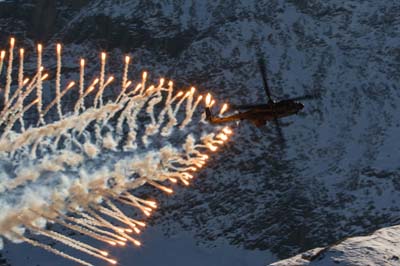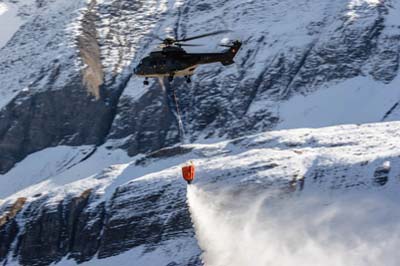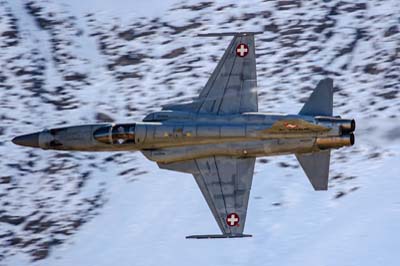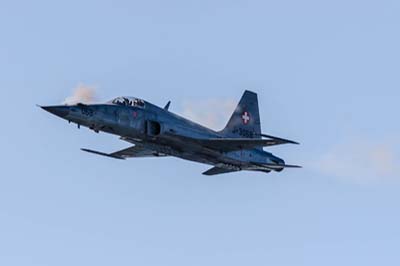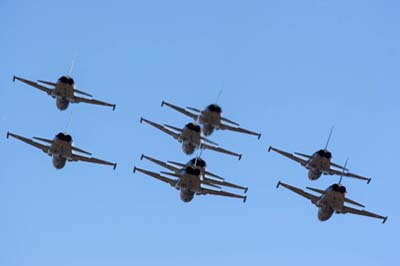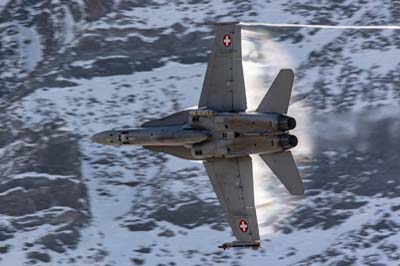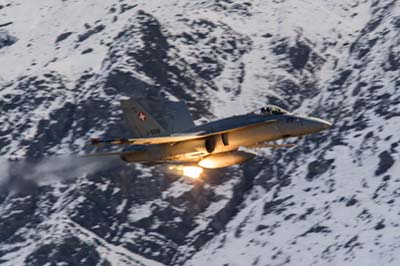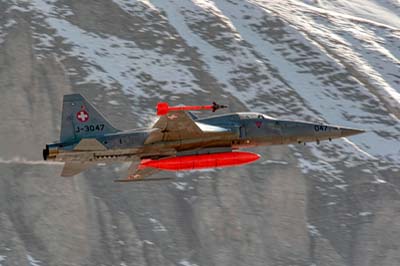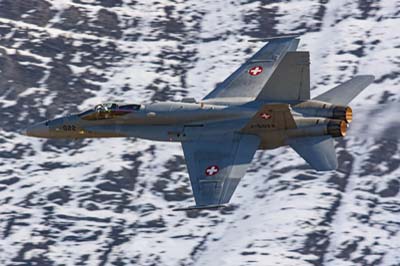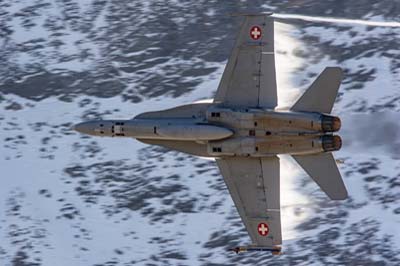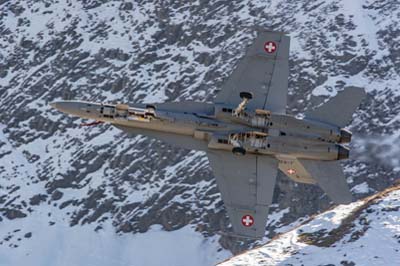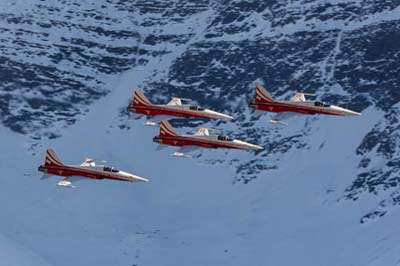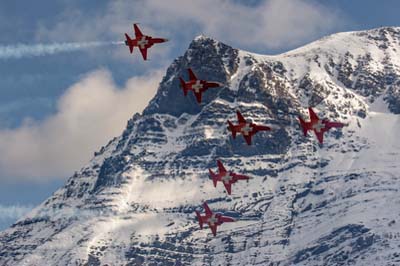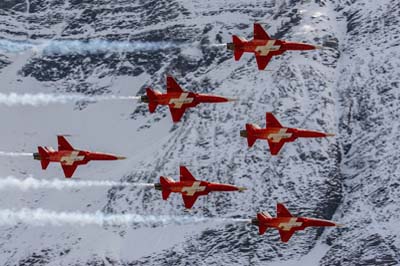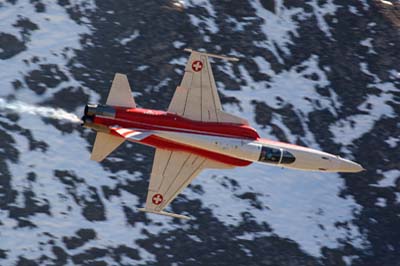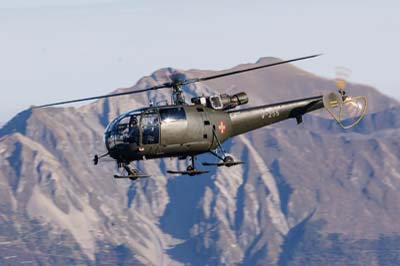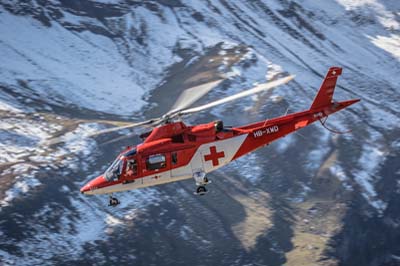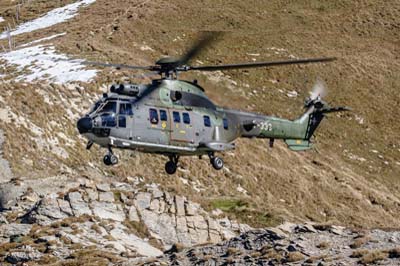Swiss Air Force's Air Power Demonstration
Ebenfluh Firing Range, Axalp
October 12-13, 2005
|
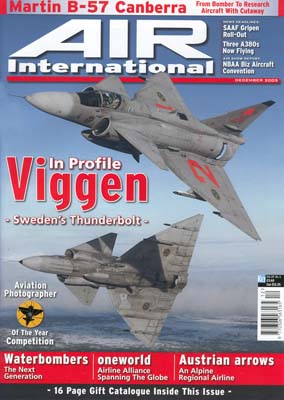 Philip Stevens reports on the Swiss Air Force's annual air power demonstration, which takes place at their spectacular Ebenfluh firing range, high in the Alps, near the summit of the 7614 feet (2321m) high Axalphorn Mountain, in the Bernese Oberland of central Switzerland.
Philip Stevens reports on the Swiss Air Force's annual air power demonstration, which takes place at their spectacular Ebenfluh firing range, high in the Alps, near the summit of the 7614 feet (2321m) high Axalphorn Mountain, in the Bernese Oberland of central Switzerland.
This year the show was repeated over the two planned days of October 12 and 13, in perfect weather conditions. An estimated 2,000 spectators attended on the first day, many having started the 1½ to 2½ hour ascent on foot before dawn. A further 300 VIPs and 30 accredited members of the Press were flown up each day by either an Aérospatiale AS.332M-1 Super Puma (TH-89) or a Eurocopter AS.532UL Cougar (TH-98). A flight of just six minutes from Meiringen air base, some 6,000 feet (1800m) below.
The mornings, from 08:30, were used to rehearse the afternoon's flying demonstrations, which began at 14:00hrs. To the second, the show opened with a Cougar helicopter demonstrating the RUAG Aerospace Integrated Self Protection System (ISSYS), by ejecting 128 flares. Further helicopter displays followed with an Aérospatiale SA.316B Alouette III simulating a mountain rescue and a pair of Cougars dropping water on to the frozen mountainside, as part of fire-fighting demonstration. |
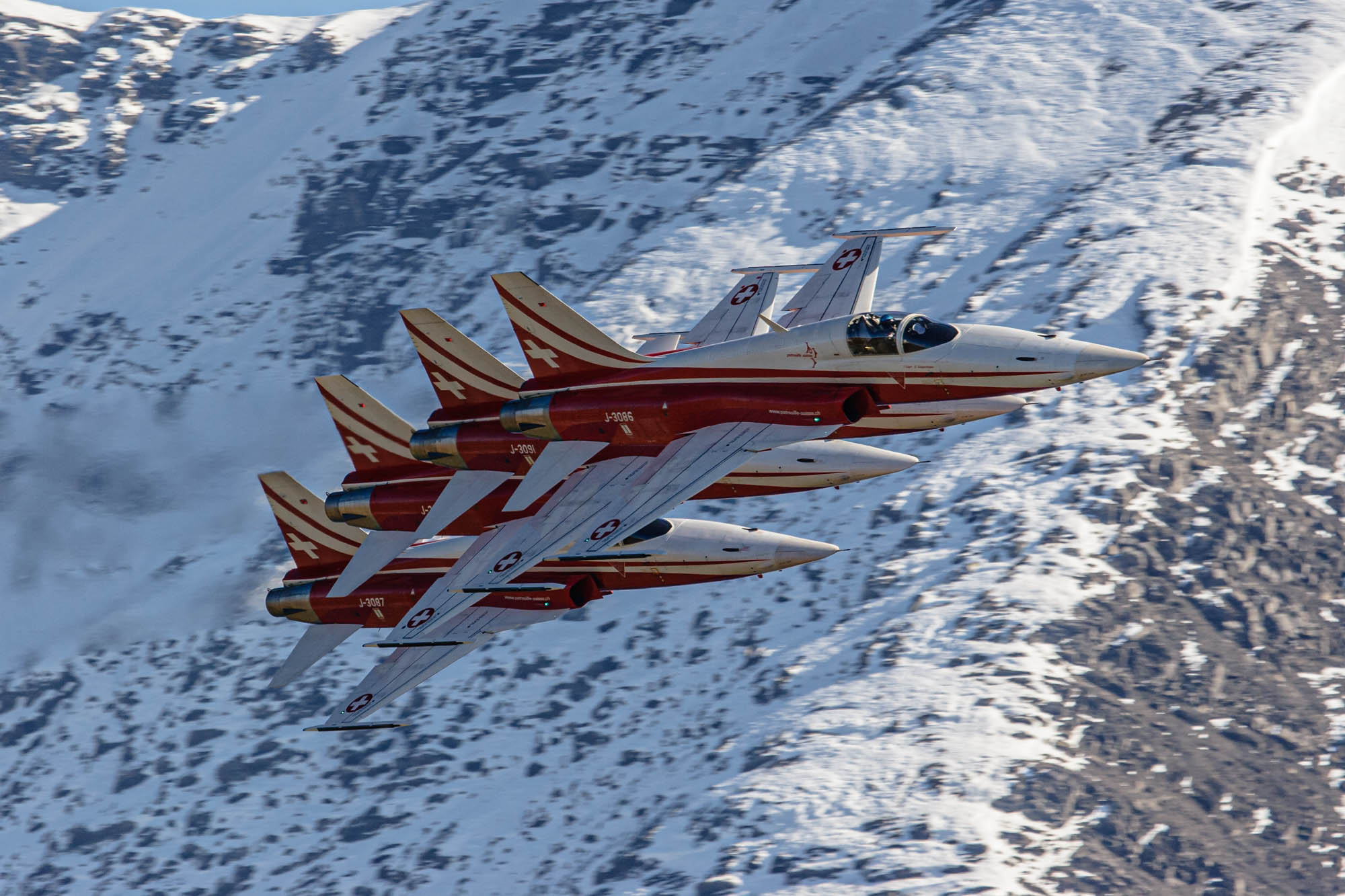 |
The Patrouille Suisse with their Northrop F-5E Tiger IIs flying in close formation through the narrow Axalp valley,
closed the show in style each day. |
| Left to right: What a show opener, Eurocopter AS.532UL Cougar ejecting 128 flares using it's 'ISSYS' self-protection system. Eurocopter AS.532UL Cougar (Swiss Air Force T-341), showing its versatility by water bombing the mountainside as part of the fire-fighting demonstration. |
| Fast jet action began with four pairs of Northrop F-5E Tiger II from Fliegerstaffel 8 based at Meiringen. Flying figure-of-eight patterns, the F-5E pilots, all part-time militia personnel, attacked targets set up on the mountainside from all four points of the compass. With short bursts from the two nose mounted 20mm M39 cannon, they fired at the pairs of 20-foot (6m) wide orange cloth targets. When flying across the narrow valley, the jets approach the shear mountainside and pull up into a steep climb and pass inverted over the mountain peak, this is truly breath taking. |
| Left to right: F-5E Tiger II (J-3068);
These two west facing 20 foot (6m) wide orange cloth targets were erected for each days flying. The dust and numerous holes were a result of several passes from the Northrop F-5E Tiger IIs, firing from their two nose mounted Colt-Browning 20mm M39 cannon; A Swiss Air Force's F-5E Tiger II (J-3068) live firing from its two nose mounted 20mm M39 cannon. The aircraft holds 280 rounds of ammunition for each gun and fires at a rate of 1500 rounds a minute. The F-5E was firing between two sections of spectators at targets that were no more than 250 yards (230m) away from the crowd line; The closing fly past of the F-5Es. |
| The F-5s gave way to six Boeing F/A-18C/D Hornets. Firstly in a demonstration of 'Interception and Identification' two F/A-18Cs, performed a simulated Combat Air Patrol (CAP), intercepting two 'unsuspecting' and unidentified F-5Es, each with orange painted central fuel tanks and dummy AIM-9P Sidewinder missiles. Whilst this was a simulation it is a very necessary exercise. During the World Economic Forum held at Davos each January, the Swiss Air Force fly around 200 CAP missions in the week. Later two pairs of F/A-18s, descending at a 10º angle of attack, fired bursts of 240 rounds at the targets during several passes. The F/A-18C is armed with an internal nose mounted 20mm M61 Vulcan cannon. It is a hydraulically driven, six-barrelled, rotary action, air-cooled, electrically fired weapon. It has selectable rates of fire of either 4000 or 6000 rounds per minute. |
| Left to right: F/A-18C Hornet (J-5019) fitted with an AN/ASS-38 FLIR pod on the port fuselage station. The flares are released from the four black box shapes seen under the intake to the rear of the centreline fuel tank. These ALE-47 dispensers are loaded with a magazine of 30 flares each;
Swiss Air Force F-5E Tiger II (J-3047) flying in the Combat Air Patrol interception and identification simulation, as an 'enemy' aircraft. The orange Day-Glo paint on the Sidewinder and the centre line fuel tank is used to identify the aircraft when engaged in Air Combat Manoeuvring (ACM) dog fighting. It is carrying an AIM-9P Sidewinder training round. |
Left to right: F/A-18C Hornet (J-5022) solo display.
After joining up to form a six-ship formation, the Payerne based F/A-18s flew through the valley, to mark the start of an exciting solo display. This included numerous high-G turns, a slow high alpha pass and with wheels and arrestor hook down and the refuelling probe extended, they made a slow barrel role.
The finale to the show was a 20-minute display by the Patrouille Suisse in their distinctive red and white F-5Es. After seeing their formation flying routines at other air shows, you would not believe how much more impressive they are when performed through the narrow snow covered Axalphorn valley. The whole event was a thrilling experience, one I hope to repeat. |
| The Patrouille Suisse performing they display against a backdrop of stunning mountain scenery. |
| Left to right: The reliable Aérospatiale SA.316B Alouette III (V-255). It was delivered to the Swiss Air Force in the 1970s. A number of Alouettes were used for liaison duties, range safety checks and two actual mountain rescues during the show; Agusta A109K2 (HB-XWD) owned by Schweiz.Luftambulanz AG arrived each day at around 08:30. It was held on standby as an air ambulance and crewed by para-medics; Eurocopter AS.532UL Cougar (Swiss Air Force T-333) is about to touch down on the small landing area beside the Control Tower. Each day eight of these Helicopters brought in 300 VIPs. Note the 'ISSYS' self-protection system to the left of the serial number. |
| The Axalp Air Power Demonstration is no ordinary air show. It is very weather dependent, although scheduled over two days, a reserve day is put aside should the weather be too bad earlier in the week. This was the case in 2003 when there was a reported risk of avalanches and the demonstration was postponed to the Friday. Getting up to the range is difficult if not hazardous. This year the weather was very mild, other years have seen the temperatures plummet to well below freezing. |
 Philip Stevens reports on the Swiss Air Force's annual air power demonstration, which takes place at their spectacular Ebenfluh firing range, high in the Alps, near the summit of the 7614 feet (2321m) high Axalphorn Mountain, in the Bernese Oberland of central Switzerland.
Philip Stevens reports on the Swiss Air Force's annual air power demonstration, which takes place at their spectacular Ebenfluh firing range, high in the Alps, near the summit of the 7614 feet (2321m) high Axalphorn Mountain, in the Bernese Oberland of central Switzerland.
